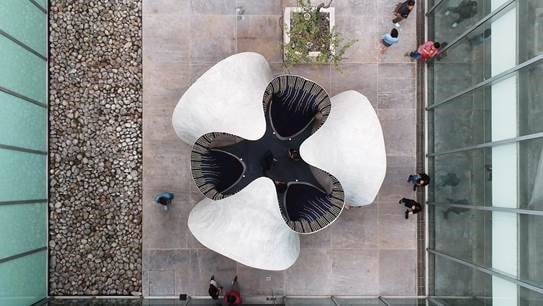{{item.title}}
{{item.text}}

{{item.text}}
The answers to the pressing problems we face today don’t lie in single, grand solutions. The issues are far too complex for that. The solutions are more likely to take the form of many different approaches developed by people who see and understand the problems from different angles – and who are prepared to work together for the big picture. In this post, architect and structural engineer Philippe Block, Professor at the ETH Zurich Department of Architecture and Director of the National Centre of Competence in Research (NCCR) in Digital Fabrication, explains why the building construction industry could – and should – serve as a blueprint for collaborative transformation.
Let’s start with a mini-quiz: What single industry is responsible for 40% of carbon emissions, 40% of resource consumption, 40% of energy use and 40% of waste production worldwide?
Transport? Agriculture? Consumer goods? How many of you came up with buildings and construction? Because that’s the correct answer. This sector has a huge impact on our planet – as much or more than transport and the other industries that might spring more readily to mind. In my view, addressing the problems inherent in the way we construct our buildings and infrastructure could play a key role in achieving our sustainability goals. And if we’re successful in addressing the issues in construction, the approaches to collaboration that we develop could also serve as a blueprint for transformation in many other areas as well.
The problem as I see it is that we have a horribly outdated way of building. At the risk of overstating the case, over the course of decades and even centuries a model has evolved based on a ‘star’ architect who designs a building primarily with the aim of being aesthetically impressive. It’s then up to engineers to implement this aesthetic wonder safely, and for the contractors to try and build the impossible at reasonable cost.
The trouble is, no single group in the process can see all the angles. Architects, for example, can’t possibly know everything involved in creating a building – such as the engineering properties of materials or how polluting they are. The result is a serious disconnect from what’s feasible. There’s nothing like it in any other industry: it’s like car design not including the idea that a wheel has to be round. It’s not the fault of any particular party in the chain; it’s just that everyone tends to pass the buck. This is obviously catastrophic if the aim is to create sustainable buildings and infrastructures that optimally meet the necessary environmental, social and economic requirements.
KnitCandela is a sinuous concrete shell built on an ultra-lightweight, computationally designed knitted formwork that was carried from Switzerland to Mexico in a suitcase.
Photo credits: Leo Bieling
Sustainability is incredibly complex. If people and organisations try to sell an undifferentiated view of sustainability and merely jostle for position, it doesn’t get us any further at all. It will take more than one grand solution to resolve the complex sustainability and environmental challenges we face. It will require many solutions developed by the relevant experts working together and respecting and valuing the others’ input – in the recognition that no single person can possibly see all the angles.
In the case of construction, it all has to start with architects and engineers: the design team. It’s these people who have the responsibility for handling the environmental aspects of building, and also all the opportunities. If architects and engineers can work together effectively and there’s a true transfer of knowledge and skills, we can start finding ways of building using fewer and less polluting materials. Architects who are interested in what engineers have to say can draw on their expertise to create designs based on smart structural geometry rather than always relying on materials such as reinforced concrete to give strength to intrinsically bad structures.
My team and I are working on a solution that we think could be just one piece of the puzzle – but a very important one. What we’ve done is revisit historic buildings such as the great Gothic cathedrals or the Pantheon in Rome to see how the vaulted structures with which they are built can be translated into modern materials such as (unreinforced) concrete. It turns out this works very well. Remember that back then they were building incredibly complex and efficient structures with simple materials such as stone and brick.
The secret lay in geometry: these structures had just the right geometry to follow the flow of forces to the supports. There was no need for steel reinforcement, which of course didn’t even exist back then.
The fan vaulting in King’s College Chapel in Cambridge is as breathtakingly beautiful and strong as the day it was built almost 600 years ago.
Photo credits: Kurt Schmidt
One of the things we’ve come up with is applying vaulted geometries to floor plates, the bits of a building you walk on. Here I have another ‘40%’ statistic: in multistorey buildings (of at least 10 floors), which are the backbone of urban planning all over the world, 40% of the weight is in the floors. What we’re doing is using mini-vaults to replace these massive reinforced concrete floor slabs. This way we need one third of the volume of materials and only a fraction of the steel reinforcement. The vaulted floor system is super-lightweight and super low-emission, but also easily recyclable if it’s not reused (which it can be, by the way). They’re an elegant and very feasible alternative for the most banal element of every building. They can even be 3D-printed – something that wasn’t possible even three years ago.
Philippe Block and his team have implicit trust in simple materials and smart geometries: here a vaulted floor plate.
Photo credits: BRG
If people are sceptical as to whether the kind of structures I’m talking about work in practice, I remind them that buildings based on curved vaults and domes using unreinforced materials, such as the Pantheon in Rome, the great European Gothic cathedrals, and even the tile-vaulted floors of Grand Central Station in New York, have been standing for hundreds or even thousands of years.
Of course it also helps to have contemporary structures showcasing these geometries in new buildings. In 2016, for instance, we created the Armadillo Vault for the Biennale International Architecture Exhibition in Venice, using funicular geometry to create a structure made entirely of limestone pieces – assembled without mortar, reinforcement or glue – spanning 16 metres. Another exciting example of an extreme shell structure, this time in concrete, is the HiLo unit of the NEST (Next Evolution in Sustainable Building Technologies) building on the campus of Empa (the Swiss Federal Laboratories for Materials Science and Technology) in Dübendorf near Zurich. It will soon be open to the public, and I’m confident it will kickstart the introduction of this kind of disruptive building approach.
Scaling up a new technology like this involves more than appealing to people’s imagination. There are also many hoops to jump through in the form of building regulation, certification, fire tests, load tests, and so on. Naturally we have to ensure that new techniques and solutions are safe and compliant, but in my view the industry is too risk-averse and not going as fast as it could to keep up with innovation brought by research. It would be good to see more clients – including private individuals – taking the plunge. Naturally there’s always a risk in adopting something new, but in our experience, even when pushing the boundaries, the risk is always financial.
It’s a promising sign that there’s increasing interest on the part of governments in incorporating historical principles in building. We have partnerships in South Africa and India where they are seeing the benefits. Good examples that we were involved in are the Sustainable Urban Dwelling Unit (SUDU) in Ethiopia and the Mapungubwe National Park Interpretation Centre in South Africa. These projects have demonstrated how low-pollution tile vaulting techniques using locally-made, pressed soil-cement tiles can generate local entrepreneurship and create income and jobs for local communities.
Technology or magic? The Armadillo Vault for the Biennale International Architecture Exhibition in Venice spans 16 metres without mortar, reinforcement or glue.
Photo credits: Iwan Baan
The key is to make these revamped ‘old’ technologies relevant and acceptable. As in so many cases these days, digital technology is an important part of the puzzle. I’ve already mentioned that our vaulted structures can be 3D-printed. Another thing we can be doing is using computation to find contemporary structures that will match historic structures. This is very important, as a lot of what the construction industry will be doing in the years to come is renovating. It would be a great step forward if we could drastically reduce the use of new materials needed to repair old structures.
We need to apply the technology we have to make a philosophy of Reduce, Reuse and Recycle happen. Reducing means trying to change as little as possible, and then building on the basis of smart geometries that minimise the use of materials. Reusing means, for example, giving new, more significant purposes to old components and buildings. Only then do we recycle. Realise that almost all the construction waste produced worldwide ends up in landfill – Switzerland being one of the notable exceptions. That’s untenable.
I was pleased to hear that PwC and the WWF are working together on the idea of circular economy. Circularity – basically an economic system designed to eliminate waste and promote the continual use of resources – is a crucial approach to avoid irresponsibility and find effective ways of addressing the environmental and sustainability issues we face.
I agree with David Attenborough that we’re past the acceptable point where it’s enough to leave the planet as we found it. We have to return to a world that is better: a planet in balance. To actively compensate for the wrongs of the last decades, we need to do more.
As I’ve tried to show using the example of the building construction industry I’m passionate about, this requires a new kind of team and new kinds of cooperation. We have to learn to think and work across boundaries, and respect and learn from each other’s expertise. It’s when this happens that we can come up with amazing ideas that work – such as vaulted floor structures that weigh far less, produce less pollution, and can be made with 3D printers using local resources. The way I see it, that’s disruption at its best.
Trust in Transformation. Place your trust in a partner who always thinks a step ahead when it comes to corporate responsibility.
Professor Philippe Block is adept at spanning different worlds. A multiple award-winning architect and structural engineer who studied at the VUB in Belgium and MIT in the US, in his current roles he (literally) builds bridges between academic research and the practical end of building construction.
At the Institute of Technology in Architecture at ETH Zurich he co-directs the Block Research Group (BRG) together with Dr Tom Van Mele. He is also director of the Swiss National Centre of Competence in Research (NCCR) in Digital Fabrication and a member of the board of directors of LafargeHolcim.
The focuses of Block’s research include computational form finding, and optimising and constructing curved surface structures – especially unreinforced masonry vaults and concrete shells. He applies research in practice with contracts including the structural assessment of historic monuments and the design and engineering of novel shell structures.
Portrait photo credits: Elisabeth Real
#social#
Register to get notified about new Transformation Stories.
{{item.text}}

{{item.text}}





